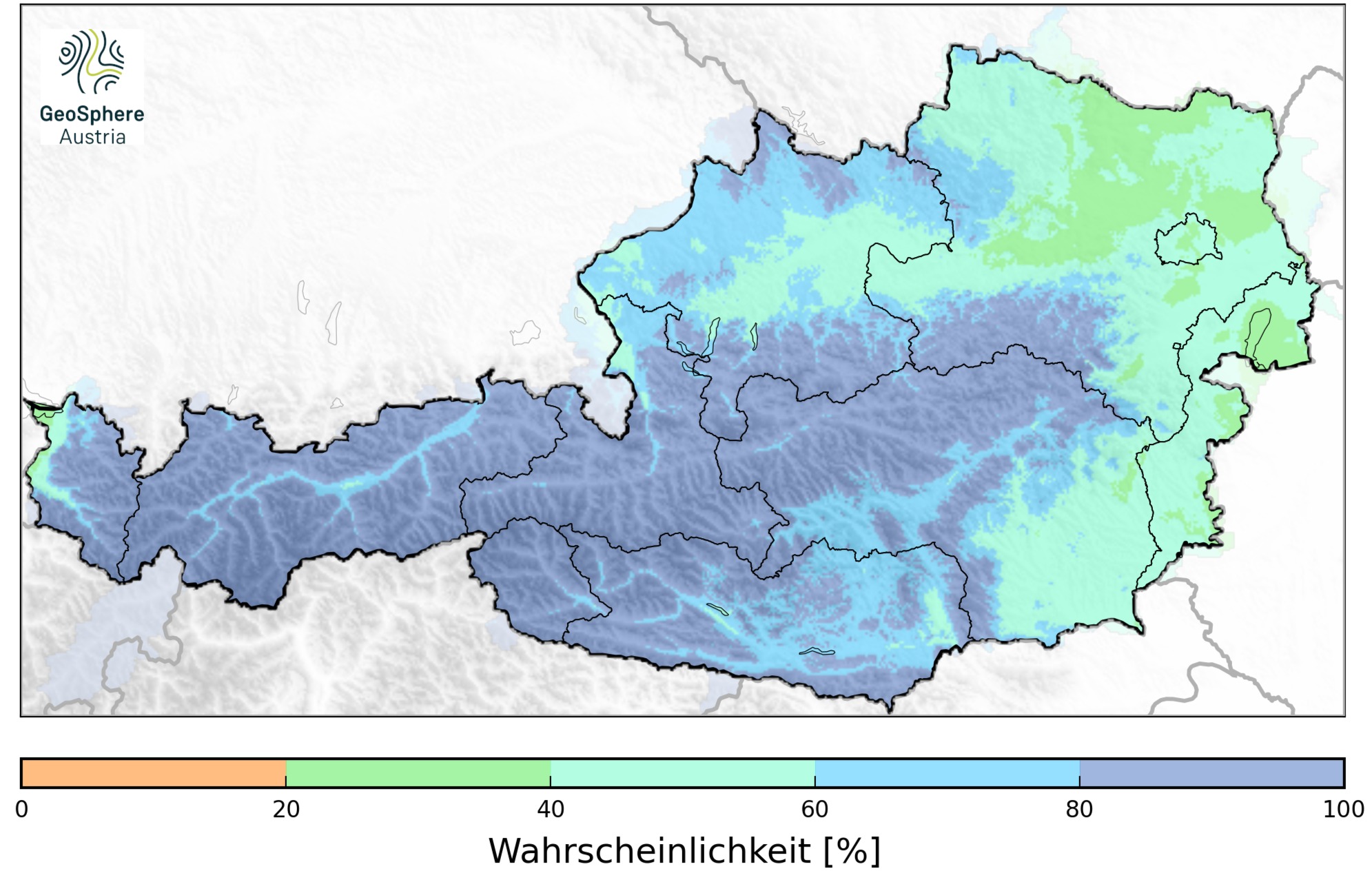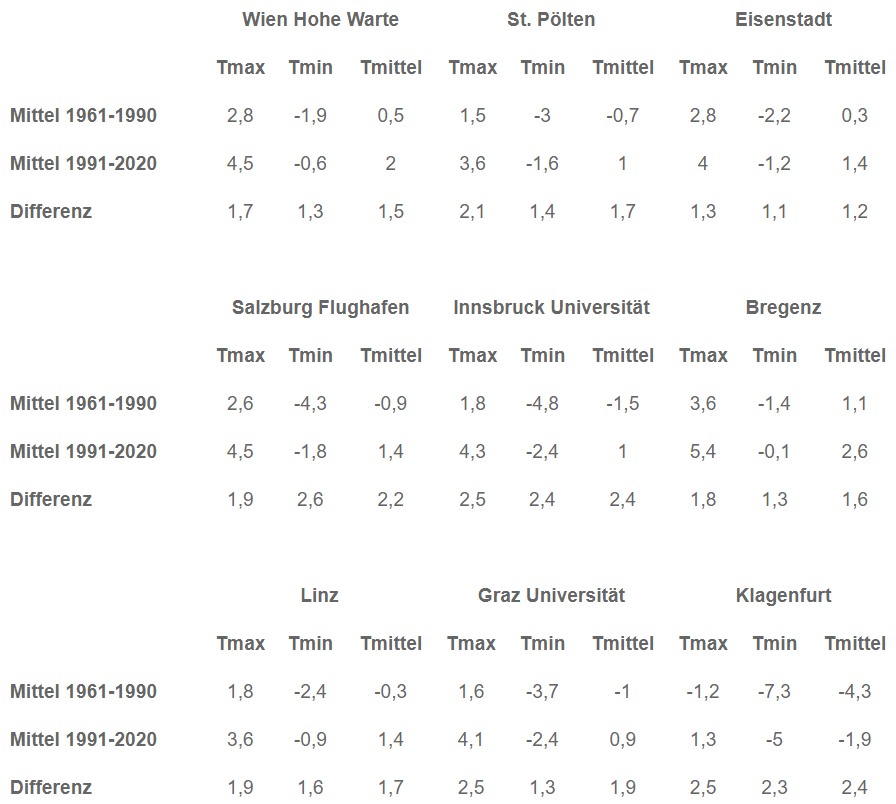White Christmas increasingly rare
An analysis by GeoSphere Austria shows that Christmas in Austria has become one to two degrees warmer on average in recent decades and the chance of a white Christmas at low altitudes has decreased significantly. Since 2011, there has been almost no day with snow cover at Christmas in the provincial capitals.
The climate is getting warmer and is also having an impact on the Christmas holidays. "Although there are major fluctuations from year to year, there has been a clear trend towards increasingly milder temperatures at Christmas over the last few decades," says Alexander Orlik, climatologist at GeoSphere Austria. "If you compare the average temperature on 24, 25 and 26 December in the period from 1961 to 1990 with the period from 1991 to 2020, you can see a warming of around one to two degrees in the provincial capitals of Austria, for example."
(Info: For data on the provincial capitals, see figure below)
Due to the warming temperatures, a white Christmas has become much rarer at low altitudes in Austria. This is because the temperature in the lowlands of Austria is increasingly above 0 degrees in December. As a result, precipitation tends to fall as rain, and snow that has fallen melts away more quickly than it used to.
A white Christmas is reasonably reliable in valleys above around 800 metres above sea level. Here, too, it has become milder in recent decades, but it is still often cold enough for snowfall.
For example, in the last 30 years, Bad Mitterndorf (ST, 814 metres above sea level) has seen a blanket of snow at Christmas 25 times, Schoppernau (V, 835 m) 26 times and Weissensee (K, 949 m) 16 times.
The chance of a white Christmas at low altitudes in Austria has decreased in recent decades:
A blanket of snow on 24, 25 or 26 December could be expected on average every two to three years in most provincial capitals between 1961 and 1990, and every one to two years in Innsbruck.
In the period from 1991 to 2020, snow cover on the 24th, 25th or 26th occurred on average every two to three years in Innsbruck, every three to four years in Graz, Klagenfurt and Salzburg and every four to six years in Vienna, Eisenstadt, St. Pölten, Linz and Bregenz.
"In the recent past, we have even had a phase with very little snow," says climatologist Orlik, "since 2011, there have been almost no white Christmas days at low altitudes in Austria. Since then, there has only been a blanket of snow on 24, 25 or 26 December in the provincial capitals, for example, in Innsbruck in 2011, Vienna and Eisenstadt in 2012, Salzburg in 2014, Innsbruck in 2020 and Vienna, Graz and Klagenfurt in 2021."
(Note: "Snow cover" is defined here as at least 1 centimetre of snow at more than 50 per cent of the observation site).
The provincial capital with the longest current "green streak" is St. Pölten. The last time there was a blanket of snow at least one centimetre high on at least one Christmas Day (24th or 25th or 26th December) was in 2007.
This was last the case in Linz and Bregenz in 2010, in Eisenstadt in 2012, in Salzburg in 2014, in Innsbruck in 2020 and in Vienna, Graz and Klagenfurt in 2021.
Anyone looking for Christmas snow records has to go way back in the data. The Christmas record for all provincial capitals is held by the Innsbruck Airport weather station with 96 centimetres of snow on 24 December 1962. The other snow records for the provincial capitals for Christmas are: 55 cm at Graz Airport on 25 December 1994, 50 cm in St. Pölten on 24 December 1969, 47 cm in Klagenfurt in 1994 and 40 cm in Salzburg on 24 December 1962. Pölten on 24.12.1969, 47 cm in Klagenfurt in 1994, 40 cm in Salzburg on 24.12.1962, 39 cm in Eisenstadt on 24.12.1969, 47 cm in Vienna Mariabrunn on 24.12.1969, 26 cm in Bregenz on 26.12.1969 and in Linz (airport) the record snow depth is 25 cm on 25 December 1969.
The cold records are also far behind. In the Austria-wide evaluation of all GeoSphere Austria weather stations below 1400 metres above sea level, the coldest record was -29.0 °C in Tamsweg (S) on the night of 26 December 1944. 1962 was also extreme, with the highest(!) temperature on 25 December in Vils (Tyrol, Reutte district) being -19.8 °C. In Kitzbühel, it was -27.9 °C in the night from 24 to 25 December 1962.
The Christmas heat record for the whole of Austria is held by the Salzburg Airport weather station with 19.1 °C on 25 December 2013.
It is not yet possible to say in detail what the Christmas weather and snow conditions will look like in 2024. A lot is still possible in the next two weeks, especially at low altitudes in Austria. But from an altitude of around 1000 metres above sea level, many regions already have a blanket of snow that could last until Christmas from the current perspective.
Translated with DeepL.com (free version)



